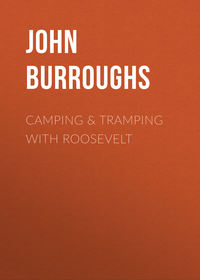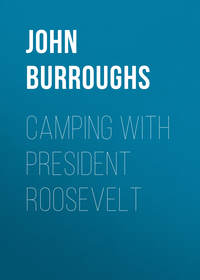 полная версия
полная версияWays of Nature
"Leopards, panthers, and jaguars are all trained in much the same manner," and in putting them through their tricks one invariable order must be observed: "Each thing done one day must be done the next day in exactly the same way; there must be no deviation from the rule." Now we do not see in this fact the way of a thinking or reflecting being, but rather the way of a creature governed by instinct or unthinking intelligence. An animal never learns a trick in the sense that man learns it, never sees through it or comprehends it, has no image of it in its mind, and no idea of the relations of the parts of it to one another; it does it by reason of repetition, as a creek wears its channel, and probably has no more self-knowledge or self-thought than the creek has. This, I think, is quite contrary to the popular notion of animal life and mentality, but it is the conclusion that I, at least, cannot avoid after making a study of the subject.
II. AN ASTONISHED PORCUPINEOne summer, while three young people and I were spending an afternoon upon a mountain-top, our dogs treed a porcupine. At my suggestion the young man climbed the tree – not a large one – to shake the animal down. I wished to see what the dogs would do with him, and what the "quill-pig" would do with the dogs. As the climber advanced the rodent went higher, till the limb he clung to was no larger than one's wrist. This the young man seized and shook vigorously. I expected to see the slow, stupid porcupine drop, but he did not. He only tightened his hold. The climber tightened his hold, too, and shook the harder. Still the bundle of quills did not come down, and no amount of shaking could bring it down. Then I handed a long pole up to the climber, and he tried to punch the animal down. This attack in the rear was evidently a surprise; it produced an impression different from that of the shaking. The porcupine struck the pole with his tail, put up the shield of quills upon his back, and assumed his best attitude of defense. Still the pole persisted in its persecution, regardless of the quills; evidently the animal was astonished: he had never had an experience like this before; he had now met a foe that despised his terrible quills. Then he began to back rapidly down the tree in the face of his enemy. The young man's sweetheart stood below, a highly interested spectator. "Look out, Sam, he's coming down!" "Be quick, he's gaining on you!" "Hurry, Sam!" Sam came as fast as he could, but he had to look out for his footing, and his antagonist did not. Still, he reached the ground first, and his sweetheart breathed more easily. It looked as if the porcupine reasoned thus: "My quills are useless against a foe so far away; I must come to close quarters with him." But, of course, the stupid creature had no such mental process, and formed no such purpose. He had found the tree unsafe, and his instinct now was to get to the ground as quickly as possible and take refuge among the rocks. As he came down I hit him a slight blow over the nose with a rotten stick, hoping only to confuse him a little, but much to my surprise and mortification he dropped to the ground and rolled down the hill dead, having succumbed to a blow that a woodchuck or a coon would hardly have regarded at all. Thus does the easy, passive mode of defense of the porcupine not only dull his wits, but it makes frail and brittle the thread of his life. He has had no struggles or battles to harden and toughen him.
That blunt nose of his is as tender as a baby's, and he is snuffed out by a blow that would hardly bewilder for a moment any other forest animal, unless it be the skunk, another sluggish non-combatant of our woodlands. Immunity from foes, from effort, from struggle is always purchased with a price.
Certain of our natural history romancers have taken liberties with the porcupine in one respect: they have shown him made up into a ball and rolling down a hill. One writer makes him do this in a sportive mood; he rolls down a long hill in the woods, and at the bottom he is a ragged mass of leaves which his quills have impaled – : an apparition that nearly frightened a rabbit out of its wits. Let any one who knows the porcupine try to fancy it performing a feat like this!
Another romancer makes his porcupine roll himself into a ball when attacked by a panther, and then on a nudge from his enemy roll down a snowy incline into the water. I believe the little European hedgehog can roll itself up into something like a ball, but our porcupine does not. I have tried all sorts of tricks with him, and made all sorts of assaults upon him, at different times, and I have never yet seen him assume the globular form. It would not be the best form for him to assume, because it would partly expose his vulnerable under side. The one thing the porcupine seems bent upon doing at all times is to keep right side up with care. His attitude of defense is crouching close to the ground, head drawn in and pressed down, the circular shield of large quills upon his back opened and extended as far as possible, and the tail stretched back rigid and held close upon the ground. "Now come on," he says, "if you want to." The tail is his weapon of active defense; with it he strikes upward like lightning, and drives the quills into whatever they touch. In his chapter called "In Panoply of Spears," Mr. Roberts paints the porcupine without taking any liberties with the creature's known habits. He portrays one characteristic of the porcupine very felicitously: "As the porcupine made his resolute way through the woods, the manner of his going differed from that of all the other kindreds of the wild. He went not furtively. He had no particular objection to making a noise. He did not consider it necessary to stop every little while, stiffen himself to a monument of immobility, cast wary glances about the gloom, and sniff the air for the taint of enemies. He did not care who knew of his coming, and he did not greatly care who came. Behind his panoply of biting spears he felt himself secure, and in that security he moved as if he held in fee the whole green, shadowy, perilous woodland world."
III. BIRDS AND STRINGSA college professor writes me as follows: —
"Watching this morning a robin attempting to carry off a string, one end of which was caught in a tree, I was much impressed by his utter lack of sense. He could not realize that the string was fast, or that it must be loosened before it could be carried off, and in his efforts to get it all in his bill he wound it about a neighboring limb. If as little sense were displayed in using other material for nests, there would be no robins' nests. It impressed me more than ever with the important part played by instinct."
Who ever saw any of our common birds display any sense or judgment in the handling of strings? Strings are comparatively a new thing with birds; they are not a natural product, and as a matter of course birds blunder in handling them. The oriole uses them the most successfully, often attaching her pensile nest to the branch by their aid. But she uses them in a blind, childish way, winding them round and round the branch, often getting them looped over a twig or hopelessly tangled, and now and then hanging herself with them, as is the case with other birds. I have seen a sparrow, a cedar-bird, and a robin each hung by a string it was using in the building of its nest. Last spring, in Spokane, a boy brought me a desiccated robin, whose feet were held together by a long thread hopelessly snarled. The boy had found it hanging to a tree.
I have seen in a bird magazine a photograph of an oriole's nest that had a string carried around a branch apparently a foot or more away, and then brought back and the end woven into the nest. It was given as a sample of a well-guyed nest, the discoverer no doubt looking upon it as proof of an oriole's forethought in providing against winds and storms. I have seen an oriole's nest with a string carried around a leaf, and another with a long looped string hanging free. All such cases simply show that the bird was not master of her material; she bungled; the trailing string caught over the leaf or branch, and she drew both ends in and fastened them regardless of what had happened. The incident only shows how blindly instinct works.
Twice I have seen cedar-birds, in their quest for nesting-material, trying to carry away the strings that orioles had attached to branches. According to our sentimental "School of Nature Study," the birds should have untied and unsnarled the strings in a human way, but they did not; they simply tugged at them, bringing their weight to bear, and tried to fly away with the loose end.
In view of the ignorance of birds with regard to strings, how can we credit the story told by one of our popular nature writers of a pair of orioles that deliberately impaled a piece of cloth upon a thorn in order that it might be held firmly while they pulled out the threads? When it came loose, they refastened it. The story is incredible for two reasons: (1) the male oriole does not assist the female in building the nest; he only furnishes the music; (2) the whole proceeding implies an amount of reflection and skill in dealing with a new problem that none of our birds possess. What experience has the race of orioles had with cloth, that any member of it should know how to unravel it in that way? The whole idea is absurd.
IV. MIMICRYTo what lengths the protective resemblance theory is pushed by some of its expounders! Thus, in the neighborhood of Rio Janeiro there are two species of hawks that closely resemble each other, but one eats only insects and the other eats birds. Mr. Wallace thinks that the bird-eater mimics the insect-eater, so as to deceive the birds, which are not afraid of the latter. But if the two hawks look alike, would not the birds come to regard them both as bird-eaters, since one of them does eat birds? Would they not at once identify the harmless one with their real enemy and thus fear them both alike? If the latter were newcomers and vastly in the minority, then the ruse might work for a while. But if there were ten harmless hawks around to one dangerous one, the former would quickly suffer from the character of the latter in the estimation of the birds. Birds are instinctively afraid of all hawk kind.
Wallace thinks it may be an advantage to cuckoos, a rather feeble class of birds, to resemble the hawks, but this seems to me far-fetched. True it is, if the sheep could imitate the wolf, its enemies might keep clear of it. Why, then, has not this resemblance been brought about? Our cuckoo is a feeble and defenseless bird also, but it bears no resemblance to the hawk. The same can be said of scores of other birds.
Many of these close resemblances among different species of animals are no doubt purely accidental, or the result of the same law of variation acting under similar conditions. We have a hummingbird moth that so closely in its form and flight and manner resembles a hummingbird, that if this resemblance brought it any immunity from danger it would be set down as a clear case of mimicry. There is such a moth in England, too, where no hummingbird is found. Why should not Nature repeat herself in this way? This moth feeds upon the nectar of flowers like the hummingbird, and why should it not have the hummingbird's form and manner?
Then there are accidental resemblances in nature, such as the often-seen resemblance of knots of trees and of vegetables to the human form, and of a certain fungus to a part of man's anatomy. We have a fly that resembles a honey-bee. In my bee-hunting days I used to call it the "mock honey-bee." It would come up the wind on the scent of my bee box and hum about it precisely like a real bee. Of course it was here before the honey-bee, and has been evolved quite independently of it. It feeds upon the pollen and nectar of flowers like the true bee, and is, therefore, of similar form and color. The honey-bee has its enemies; the toads and tree-frogs feed upon it, and the kingbird captures the slow drone.
When an edible butterfly mimics an inedible or noxious one, as is frequently the case in the tropics, the mimicker is no doubt the gainer.
It makes a big difference whether the mimicker is seeking to escape from an enemy, or seeking to deceive its prey. I fail to see how, in the latter case, any disguise of form or color could be brought about.
Our shrike, at times, murders little birds and eats out their brains, and it has not the form, or the color, or the eye of a bird of prey, and thus probably deceives its victims, but there is no reason to believe that this guise is the result of any sort of mimicry.
V. THE COLORS OF FRUITSMr. Wallace even looks upon the nuts as protectively colored, because they are not to be eaten. But without the agency of the birds and the squirrels, how are the heavy nuts, such as the chestnut, beechnut, acorn, butternut, and the like, to be scattered? The blue jay is often busy hours at a time in the fall, planting chestnuts and acorns, and red squirrels carry butternuts and walnuts far from the parent trees, and place them in forked limbs and holes for future use. Of course, many of these fall to the ground and take root. If the protective coloration of the nuts, then, were effective, it would defeat a purpose which every tree and shrub and plant has at heart, namely, the scattering of its seed. I notice that the button-balls on the sycamores are protectively colored also, and certainly they do not crave concealment. It is true that they hang on the naked trees till spring, when no concealment is possible. It is also true that the jays and the crows carry away the chestnuts from the open burrs on the trees where no color scheme would conceal them. But the squirrels find them upon the ground even beneath the snow, being guided, no doubt, by the sense of smell.
The hickory nut is almost white; why does it not seek concealment also? It is just as helpless as the others, and is just as sweet-meated. It occurs to me that birds can do nothing with it on account of its thick shell; it needs, therefore, to attract some four-footed creature that will carry it away from the parent tree, and this is done by the mice and the squirrels. But if this is the reason of its whiteness, there is the dusky butternut and the black walnut, both more or less concealed by their color, and yet having the same need of some creature to scatter them.
The seeds of the maple, and of the ash and the linden, are obscurely colored, and they are winged; hence they do not need the aid of any creature in their dissemination. To say that this is the reason of their dull, unattractive tints would be an explanation on a par with much that one hears about the significance of animal and vegetable coloration. Why is corn so bright colored, and wheat and barley so dull, and rice so white? No doubt there is a reason in each case, but I doubt if that reason has any relation to the surrounding animal life.
The new Botany teaches that the flowers have color and perfume to attract the insects to aid in their fertilization – a need so paramount with all plants, because plants that are fertilized by aid of the wind have very inconspicuous flowers. Is it equally true that the high color of most fruits is to attract some hungry creature to come and eat them and thus scatter the seeds? From the dwarf cornel, or bunch-berry, in the woods, to the red thorn in the fields, every fruit-bearing plant and shrub and tree seems to advertise itself to the passer-by in its bright hues. Apparently there is no other use to the plant of the fleshy pericarp than to serve as a bait or wage for some animal to come and sow its seed. Why, then, should it not take on these alluring colors to help along this end? And yet there comes the thought, may not this scarlet and gold of the berries and tree fruits be the inevitable result of the chemistry of ripening, as it is with the autumn foliage? What benefit to the tree, directly or indirectly, is all this wealth of color of the autumn? Many of the toadstools are highly colored also; how do they profit by it? Many of the shells upon the beach are very showy; to what end? The cherry-birds find the pale ox-hearts as readily as they do the brilliant Murillos, and the dull blue cedar berries and the duller drupes of the lotus are not concealed from them nor from the robins. But it is true that the greenish white grapes in the vineyard do not suffer from the attacks of the birds as do the blue and red ones. The reason probably is that the birds regard them as unripe. The white grape is quite recent, and the birds have not yet "caught on."
Poisonous fruits are also highly colored; to what end? In Bermuda I saw on low bushes great masses of what they called "pigeon-berries" of a brilliant yellow color and very tempting, yet I was assured they were poisonous. It would be interesting to know if anything eats the red berries of our wild turnip or arum. I doubt if any bird or beast could stand them. Wherefore, then, are they so brightly colored? I am also equally curious to know if anything eats the fruit of the red and white baneberry and the blue cohosh.
The seeds of some wild fruit, such as the climbing bitter-sweet, are so soft that it seems impossible they should pass through the gizzard of a bird and not be destroyed.
The fruit of the sumac comes the nearest to being a cheat of anything I know of in nature – a collection of seeds covered with a flannel coat with just a perceptible acid taste, and all highly colored. Unless the seed itself is digested, what is there to tempt the bird to devour it, or to reward it for so doing?
In the tropics one sees fruits that do not become bright colored on ripening, such as the breadfruit, the custard apple, the naseberry, the mango. And tropical foliage never colors up as does the foliage of northern trees.
VI. INSTINCTMany false notions seem to be current in the popular mind about instinct. Apparently, some of our writers on natural history themes would like to discard the word entirely. Now instinct is not opposed to intelligence; it is intelligence of the unlearned, unconscious kind, – the intelligence innate in nature. We use the word to distinguish a gift or faculty which animals possess, and which is independent of instruction and experience, from the mental equipment of man which depends mainly upon instruction and experience. A man has to be taught to do that which the lower animals do from nature. Hence the animals do not progress in knowledge, while man's progress is almost limitless. A man is an animal born again into a higher spiritual plane. He has lost or shed many of his animal instincts in the process, but he has gained the capacity for great and wonderful improvement.
Instinct is opposed to reason, to reflection, to thought, – to that kind of intelligence which knows and takes cognizance of itself. Instinct is that lower form of intelligence which acts through the senses, – sense perception, sense association, sense memory, – which we share with the animals, though their eyes and ears and noses are often quicker and keener than ours. Hence the animals know only the present, visible, objective world, while man through his gift of reason and thought knows the inward world of ideas and ideal relations.
An animal for the most part knows all that it is necessary for it to know as soon as it reaches maturity; what it learns beyond that, what it learns at the hands of the animal-trainer, for instance, it learns slowly, through a long repetition of the process of trial and failure. Man also achieves many things through practice alone, or through the same process of trial and failure. Much of his manual skill comes in this way, but he learns certain things through the exercise of his reason; he sees how the thing is done, and the relation of the elements of the problem to one another. The trained animal never sees how the thing is done, it simply does it automatically, because certain sense impressions have been stamped upon it till a habit has been formed, just as a man will often wind his watch before going to bed, or do some other accustomed act, without thinking of it.
The bird builds her nest and builds it intelligently, that is, she adapts means to an end; but there is no reason to suppose that she thinks about it in the sense that man does when he builds his house. The nest-building instinct is stimulated into activity by outward conditions of place and climate and food supply as truly as the growth of a plant is thus stimulated.
As I look upon the matter, the most wonderful and ingenious nests in the world, as those of the weaver-birds and orioles, show no more independent self-directed and self-originated thought than does the rude nest of the pigeon or the cuckoo. They evince a higher grade of intelligent instinct, and that is all. Both are equally the result of natural promptings, and not of acquired skill, or the lack of it. One species of bird will occasionally learn the song of another species, but the song impulse must be there to begin with, and this must be stimulated in the right way at the right time. A caged English sparrow has been known to learn the song of the canary caged with or near it, but the sparrow certainly inherits the song impulse. One has proof of this when he hears a company of these sparrows sitting in a tree in spring chattering and chirping in unison, and almost reaching an utterance that is song-like. Our cedar-bird does not seem to have the song impulse, and I doubt if it could ever be taught to sing. In like manner our ruffed grouse has but feeble vocal powers, and I do not suppose it would learn to crow or cackle if brought up in the barn-yard. It expresses its joy at the return of spring and the mating season in its drum, as do the woodpeckers.
The recent English writer Richard Kearton says there is "no such dead level of unreasoning instinct" in the animal world as is popularly supposed, and he seems to base the remark upon the fact that he found certain of the cavities or holes in a hay-rick where sparrows roosted lined with feathers, while others were not lined. Such departures from a level line of habit as this are common enough among all creatures. Instinct is not something as rigid as cast iron; it does not invariably act like a machine, always the same. The animal is something alive, and is subject to the law of variation. Instinct may act more strongly in one kind than in another, just as reason may act more strongly in one man than in another, or as one animal may have greater speed or courage than another of the same species. It would be hard to find two live creatures, very far up in the scale, exactly alike. A thrush may use much mud in the construction of its nest, or it may use little or none at all; the oriole may weave strings into its nest, or it may use only dry grasses and horse-hairs; such cases only show variations in the action of instinct. But if an oriole should build a nest like a robin, or a robin build like a cliff swallow, that would be a departure from instinct to take note of.
Some birds show a much higher degree of variability than others; some species vary much in song, others in nesting and in feeding habits. I have never noticed much variation in the songs of robins, but in their nesting-habits they vary constantly. Thus one nest will be almost destitute of mud, while another will be composed almost mainly of mud; one will have a large mass of dry grass and weeds as its foundation, while the next one will have little or no foundation of the kind. The sites chosen vary still more, ranging from the ground all the way to the tops of trees. I have seen a robin's nest built in the centre of a small box that held a clump of ferns, which stood by the roadside on the top of a low post near a house, and without cover or shield of any sort. The robin had welded her nest so completely to the soil in the box that the whole could be lifted by the rim of the nest. She had given a very pretty and unique effect to the nest by a border of fine dark rootlets skillfully woven together. The song sparrow shows a high degree of variability both in its song and in its nesting-habits, each bird having several songs of its own, while one may nest upon the ground and another in a low bush, or in the vines on the side of your house. The vesper sparrow, on the other hand, shows a much lower degree of variability, the individuals rarely differing in their songs, while all the nests I have ever found of this sparrow were in open grassy fields upon the ground. The chipping or social sparrow is usually very constant in its song and its nesting-habits, and yet one season a chippy built her nest in an old robin's nest in the vines on my porch. It was a very pretty instance of adaptation on the part of the little bird. Another chippy that I knew had an original song, one that resembled the sound of a small tin whistle. The bush sparrow, too, is pretty constant in choosing a bush in which to place its nest, yet I once found the nest of this sparrow upon the ground in an open field with suitable bushes within a few yards of it. The woodpeckers, the jays, the cuckoos, the pewees, the warblers, and other wood birds show only a low degree of variability in song, feeding, and nesting habits. The Baltimore oriole makes free use of strings in its nest-building, and the songs of different birds of this species vary greatly, while the orchard oriole makes no use of strings, so far as I have observed, and its song is always and everywhere the same. Hence we may say that the lives of some birds run much more in ruts than do those of others; they show less plasticity of instinct, and are perhaps for that reason less near the state of free intelligence.











